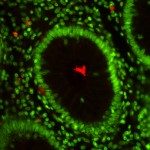Lien vers Pubmed [PMID] – 22374097
Subcell. Biochem. 2012;59:363-88
Phosphoinositides are considered as highly dynamic players in the spatiotemporal organization of key signaling pathways, actin cytoskeleton rearrangements, establishment of cell polarity and intracellular vesicle trafficking. Their metabolism is accurately controlled and mutations in several phosphoinositide metabolizing enzymes take part in the development of human pathologies. Interestingly, evidence is accumulating that modulation of the phosphoinositide metabolism is critical for pathogenicity and virulence of many human pathogens. Given the importance of phosphoinositides, which link membrane and cytoskeleton dynamics to cell responses, it is not surprising that many invasive pathogens hijack their metabolism as part of their strategies to establish infection. In fact, according to their lifestyle, cellular pathogens use the phosphoinositide metabolism in order to trigger their uptake in nonphagocytic cells and/or modulate the maturation of the pathogen-containing vacuole to establish their replicative niche or escape in the cytosol and promote host cell survival. The last two decades have been marked by the discovery of different tactics used by cellular pathogens to modulate the phosphoinositide metabolism as part of their strategies to survive, proliferate and disseminate in a hostile environment.

